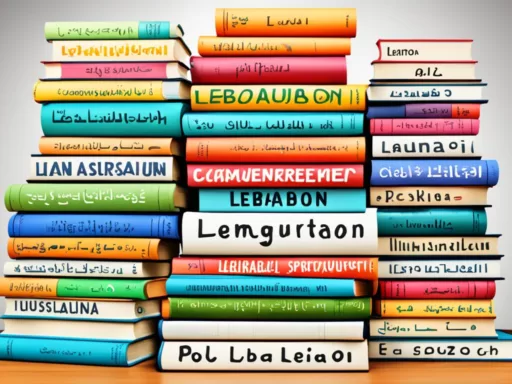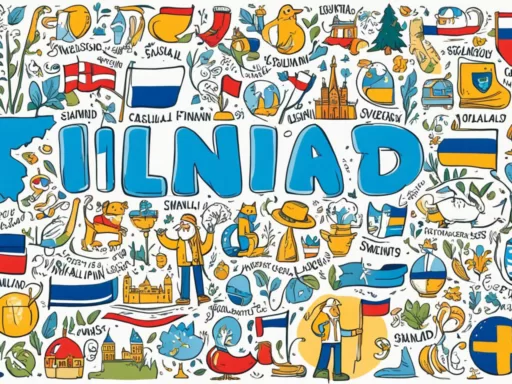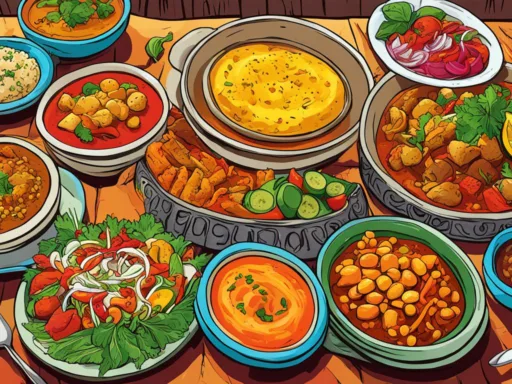Nestled between the Germanic and Romance-speaking regions of Europe lies Belgium, a country celebrated for its chocolates, waffles, and a surprisingly intricate linguistic makeup. The languages spoken in Belgium shed light on a national identity carved at the crossroads of cultures, accommodating a multicultural Belgium that balances a mix of Germanic and Latin influences.
Despite the potential challenges posed by its diverse tongues, Belgium’s linguistic landscape tells a story of cultural fusion and political nuance. Unlike other multilingual nations, such as Switzerland, which has woven its language varieties into a united identity, Belgium finds its Belgium linguistic makeup a subject of ongoing debate, with Dutch, French, and German forming the pillars of this unique European society.
Understanding Belgium’s linguistic canvas is essential not only for the intrigued linguist but also for travelers, expats, and business professionals navigating this European heartland. The dialogue between the verbal and the cultural is ever-present here, where each language enriches the societal fabric with its distinct voice and history.
Key Takeaways
- Belgium’s unique position in Europe has birthed a nation rich in language diversity.
- Dutch, French, and German stand as the three official languages in the country, highlighting its pluralistic identity.
- The variation of Dutch spoken in Belgium, known as Flemish, accounts for the native tongue of 60 percent of the population.
- Belgium’s French-speaking community claims 40 percent of the populace, with its own set of linguistic nuances.
- A small yet significant German-speaking group completes Belgium’s official language trilogy.
- The presence of multiple languages within Belgium underscores its deep-rooted multicultural ties.
- Belgium remains an intriguing case study for linguistic, cultural, and political dynamics in a modern context.
The Multilingual Landscape of Belgium
As a nation standing at the intersection of Germanic and Romance linguistic traditions, Belgium is renowned for its linguistic plurality. The official languages Belgium — Dutch, French, and German — each play a pivotal role in the country’s cultural matrix and social administration. Understanding Belgium’s language diversity is akin to unraveling a rich tapestry, reflecting centuries of history and cultural exchange.
An Overview of the Country’s Linguistic Diversity
The foundation of Belgium language diversity rests on three main linguistic communities. The Dutch-speaking Flemish account for a majority, with their language serving as the lingua franca in the northern Flanders region and influencing the Brussels populace. Wallonia’s French speakers constitute a significant segment as well, while the German-speaking community, though smaller, holds linguistic sway in the eastern territories adjacent to Germany.
In addition to these primary languages, Belgium’s linguistic landscape is dotted with regional languages such as Luxembourgish and an array of dialects that abound throughout its regions. These dialects, including Limburgish and Brabantian among the Flemish, and Walloon and Picard among the French speakers, enhance the intricate cultural tapestry of Belgium.
The Interplay of Culture and Language in Belgium
Belgium’s cultural influence language Belgium dynamics manifest starkly in its capital, Brussels. Here, the historical prestige of French led to a linguistic transformation, establishing it as the city’s predominant tongue. Despite being enveloped by the Flemish region, Brussels experienced internal migrations and a wave of immigration from Francophone nations that further cemented the dominance of French.
The language policy Belgium has been instrumental in maintaining the balance between its linguistic groups. With careful delineation of language areas and meticulous legal frameworks governing language use in education, government, and public life, Belgium endeavors to manage its multilingualism with a steady hand. However, the quest for linguistic harmony continues as each language community upholds a deep-seated pride in their linguistic heritage.

The interaction among the multilingualism in Belgium is not merely a subject of academic interest. It plays out daily in the political sphere, in educational arenas, and in the quotidian experiences of Belgians. This resilient multilingualism makes Belgium a compelling study of how language shapes national identity, social cohesion, and cultural richness. In this European heart, languages do more than communicate; they connect, empower, and define.
Languages Spoken Belgium: A Closer Look at Official Tongues
In the nuanced cultural landscape of Belgium, language serves as a cornerstone of identity and daily life. A closer inspection reveals the intricate details and variations of the Flemish language Belgium, French language Belgium, and German language Belgium. Let’s immerse ourselves in the defining characteristics of these languages, uncovering the essence of Belgian multilingualism.

Dutch, recognized locally as Flemish, dominates the linguistic scene in the northern regions of Belgium. It’s not just a language but a symbol of regional pride and culture. The French language, with its melodious intonations, claims its place predominantly in the southern territories of Wallonia and the cosmopolitan heart of Brussels. While German, with its precise syntax, holds a special status, weaving into the eastern fabric of the Belgian borderlands.
To understand the reach of these official tongues, let’s explore their use within the nation:
| Language | Region | Percentage of First-Language Speakers | Notable Variants |
|---|---|---|---|
| Flemish (Dutch) | Flanders and Brussels | ~59% | Brabantian, West Flemish, East Flemish, Limburgish |
| French | Wallonia and Brussels | ~40% | Walloon, Picard, Champenois, Lorrain |
| German | Eastern regions (border with Germany) | ~1% | Moselle Franconian, Luxembourgish |
The Flemish language Belgium is not merely Dutch spoken in a Belgian accent; it has its own belgicisms, which are lexicons particular to Belgium. These unique word choices and colloquialisms add a local flavor to the standard Dutch, creating a rich oral and written tradition. Similarly, French language Belgium shares its roots with France’s standard French but nuances in pronunciation and vocabulary bare the marks of its Belgian identity. The German language Belgium, the least widespread of the official languages, reflects historical ties, with a Germanic tongue closely mirroring the language of its neighboring country, yet treasured within the Belgian context.
This linguistic trifecta not only underscores the cultural complexity of Belgium, but it also poses an intriguing mirage of unity in diversity—each language carrying the legacy of its people and region, yet contributing to the fabric of a shared Belgian narrative.
Understanding Regional Languages in Belgium
While the main stage of Belgium’s linguistic theater is occupied by Dutch, French, and German, the wings and backdrops are beautifully adorned with the lesser-known, yet equally captivating minority languages Belgium and dialects. These languages offer a glimpse into the regional histories and cultural nuances that enrich the nation’s heritage.
Minority Languages and Their Influence
In the lush linguistic landscape of Belgium, where language variations bloom, minority languages such as Luxembourgish and Walloon provide splashes of color and texture. The Luxembourgish language Belgium community, though small, maintains its distinct linguistic identity, particularly in the border area with Luxembourg, known as Arelerland. Acknowledged by the French Community of Belgium, Luxembourgish has a notable presence in this locality.
Similarly, Walloon language, one of the Romance French dialects Belgium, carries the torch of a once-prevalent language that still flickers in the hearts of older generations and in regional cultural expressions. Despite their reduced prevalence, these minority languages are essential threads woven into the tapestry of Belgium’s linguistic diversity.

Dialects of Dutch and French in Local Contexts
Diving into the domain of Belgian Dutch dialects, we encounter vibrant variants like Brabantian, West Flemish, East Flemish, and Limburgish. While they resonate closely with their Dutch cousins across the national border, they’re distinctly Belgian. Brabantian, for instance, is redolent with the historical influence of French, becoming something of a badge of identity for Brussels, despite the city’s linguistic shift towards French.
Across the linguistic frontier in Wallonia and certain Brussels neighborhoods, the French dialects Belgium reveals its own set of characterful accents and expressions. Walloon, Picard, Champenois, and Lorrain reflect a bygone era and continue to enchant those who seek linguistic subtlety and depth amidst standard Belgian French.
The vitality of Belgium’s regional languages and dialects lies in their ability to offer insight into the heart of the nation’s diverse communities. While some may fear these dialects and languages might dwindle with time, efforts to celebrate and preserve them help maintain their irreplaceable role in the narrative of Belgium’s culture.
Language Use in Brussels: A Unique Bilingual Environment
The city of Brussels stands as a fascinating exhibition of bilingual Brussels, with both French and Dutch holding official statuses. The capital’s linguistic landscape mirrors the complexities of cultural evolution and political history. Navigating the streets, one can not only hear the dynamic interplay of languages but also witness it by observing the street signs Brussels showcases, signaling a commitment to linguistic inclusivity.
Despite being enveloped in the Flemish region and its deep-seated Flemish roots, French dominates as the primary language of communication in Brussels. This linguistic preference traces back to the city’s past, where the French language reigned supreme due to socio-economic factors and has continued to uphold its status through ongoing migration and burgeoning international influences.
Yet, in this city that doubles as the de facto capital of Europe, English is steadily carving out space, especially within international business and political sectors. However, for the day-to-day affairs in Brussels, from ordering coffee to navigating bureaucracy, a working knowledge of French remains essential for those looking to immerse themselves fully in the local culture.
To further illustrate Brussels language usage, consider the dynamic statistics encapsulated in the following table:
| Language | Percentage of Street Signs | Spoken by Residents | Usage in Business and Administration |
|---|---|---|---|
| French | 70% | Majority | Primary |
| Dutch | 30% | Minority | Secondary |
| English | Increasingly Present | Growing Minority | Common in EU and International Affairs |
The table above reflects not just a quantitative analysis but the qualitative essence of Brussels’ bilingual heartbeat. While the percentage of French and Dutch signage represents the city’s commitment to officially embrace both linguistic spheres, the prevalence of French among the inhabitants demonstrates the historical momentum carrying the language forward. The rise of English usage underscores Brussels’ role as a global nexus and the ever-growing English-speaking expatriate community.
Brussels exudes charm through its linguistic eclecticism. The abundance of French may harken back to historical norms, yet street signs and public communications honor the Flemish heritage by providing bilingual or sometimes even trilingual information, reflecting the city’s international character and diplomatic importance.
Visitors and residents alike, traversing the heart of this vibrant city from the cobbled streets of the Grand Place to the sleek corridors of the European Parliament, live and breathe within a canvas painted with words and sounds borrowed from across the linguistic spectrum. This fusion makes Brussels not merely a city in Belgium but a tapestry of Europe itself.

Conclusion: The Dynamic Linguistic Melting Pot of Belgium
The linguistic panorama of Belgium paints a vivid illustration of multilingualism Belgium, emanating from its vibrant past and present. With the majority of its people expressing themselves in animated Flemish, a substantive part conversing in polished French, and a distinct minority weaving narratives in German, Belgium proudly stands as a beacon of embracing diversity Belgium. These three official languages, etching the very essence of Belgian identity, allow us to witness the country’s rich historical tapestry and its geopolitical ebbs and flows.
But there’s more to this narrative; the regional and minority languages, though less prevalent, are hardy blooms in Belgium’s cultural garden, further accentuating the nation’s charm. The Belgian linguistic fusion is indeed a grand affair, one where the finesse of French melds with the earthy richness of Flemish, all set against the backdrop of German preciseness. Brussels demonstrates this stunningly, with multilingual signage acting as a vivid marker of the city’s layered identity. Yet, in this evolving cityscape, English tentatively carves its niche, heralding a new dimension in the country’s dialogue of tongues.
This remarkable interweaving of dialects and idioms beckons expatriates and visitors to immerse themselves within Belgium’s alleys and avenues, challenging them to look beyond the surface and engage with its diverse linguistic heritage. Indeed, while one may navigate Brussels with conversational English, an acquaintance, if not a fluency, in its official languages remains the golden key to unfurling the soul of Belgian society. It’s this very essence of multilingual understanding and exchange that cements Belgium as a linguistic melting pot—vibrant, complex, and endlessly fascinating.
FAQ
What are the official languages of Belgium?
Belgium has three official languages: Dutch, French, and German. Dutch is primarily spoken in the Flanders region, French in Wallonia and Brussels, and German in a small eastern part of the Walloon region.
How does Belgium’s language diversity impact its culture?
Belgium’s language diversity significantly influences its culture, shaping everything from local customs to political institutions. The interplay of different language communities contributes to Belgium’s rich cultural tapestry and is a source of both pride and complexity within the nation.
Why is multilingualism important in Belgium?
Multilingualism in Belgium is important due to the country’s linguistic division into Dutch-speaking Flanders, French-speaking Wallonia, and a German-speaking minority. It facilitates communication, commerce, and political administration across these diverse linguistic regions. Additionally, it reflects Belgium’s commitment to linguistic inclusion and cultural unity.
Are there any regional languages spoken in Belgium?
Yes, aside from the three official languages, various regional languages and dialects are spoken in Belgium. These include Walloon, Picard, Champenois, Lorrain in the French-speaking areas, and Flemish dialects like Limburgish, Brabantian, and West and East Flemish in the Dutch-speaking region.
What is the difference between Flemish and Dutch?
Flemish refers to the Dutch dialects spoken in the Flanders region of Belgium. It has a range of regional accents and vocabulary that are different from the standard Dutch used in the Netherlands, although they are mutually intelligible to a large extent.
How prevalent is the French language in Brussels?
French is very prevalent in Brussels and is often considered the dominant language in the city, despite its official bilingual status. Many inhabitants speak French as a first or second language, and it is widely used in business, education, and daily life.
Can you find street signs in multiple languages in Belgium?
Yes, in bilingual regions such as Brussels, you will find street signs in both Dutch and French. However, in monolingual regions, signs will typically be in the official language of that area, either French, Dutch, or German.
Is English widely spoken in Belgium?
English is not an official language in Belgium, but it is widely spoken, especially in Brussels due to its international institutions and status as a global city. Many Belgians speak English as a second or third language.
How do language policies affect life in Belgium?
Language policies in Belgium determine which language is used for government services, education, and other official matters in a given area. They aim to ensure that all linguistic communities are represented and that the rights of speakers of each official language are respected.
What is done to preserve minority languages in Belgium?
While Belgium’s minority languages do not have official status, efforts are made to preserve them through cultural organizations and education. Local initiatives and associations promote the use and study of regional dialects and minority languages.






